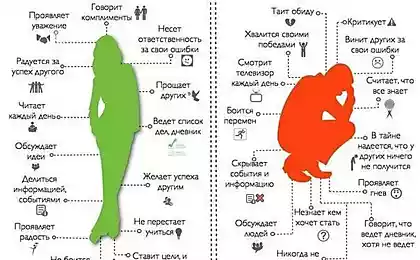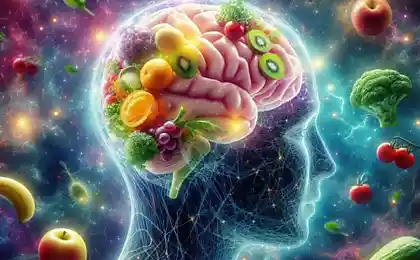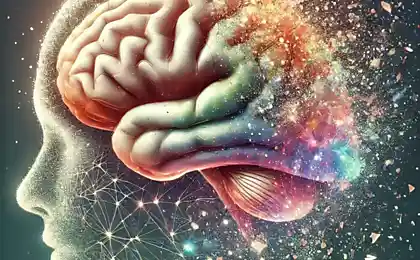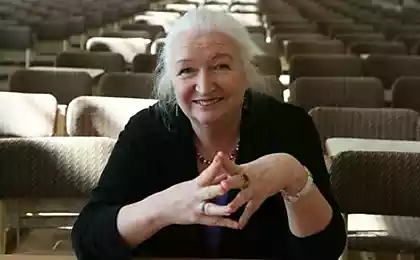519
How to get rid of any dependence on the method of Shichko
In computing and programming is widely used organize the data structure called "stack" ("stack" stack).
Adding and deleting data elements in the stack is carried out only from one end called top of the stack. Thus, the data elements entering the stack, and retrieved from the so-called LIFO principle ("Last In – First Out", "Come last goes first"). This process is similar to the analysis of a stack of coins: coins, which are placed in the stack first will be removed from her last. It is clear that the first coin will be taken, put into the stack last, as it is at the top.

Studying Shichko method to free people from tobacco, alcohol and other addictions suggests that the brain uses a certain order of processing accumulated over the day. This process can be simulated using the algorithms and structures used when writing computer programs. As we know from the works of Gennady Andreyevich Shichko and practical results of using his method, the suggestibility of a person reaches its peak in the pre-sleep state. When you consider that the information received by a person before going to sleep at that time is the most new and relevant, the logical assumption would be that the higher priority order for processing to have the data that was obtained closer to the time of going to sleep.
This is because of how quickly and thoroughly will be processed the fresh information may depend on the health and even the life of the individual. For example, for a man who was stranded on a desert island without food and water, search for food is the most urgent and vital task. If this man will lie down to sleep, the mental resources of his brain will be focused, primarily, on the question of finding food and water, and not for solution mortgage loan. Thus, we can assume that the processing of information blocks is performed by the human brain according to the principle of the stack: the brain primarily starts with the information that was received last.
Information that a person has to work against the desired bedtime, is perceived as extremely important and require urgent analysis. It begins the process of intensive brain work. Data blocks go into processing one after another, starting with the most recent of internalized and ending with the earliest. The information that the brain already worked previously handled.
And coming after the information is used to Supplement ideas about the current situation with new information and experience. This can be comparable to reverse the principle of painting: first draw the foreground objects on which to focus and then the background layers to them. Thus, the duration of the brain with information proportional to its novelty (relevance). For example, many people, especially students, familiar with the situation, when after active mental work and going to bed with an unsolved problem of the night they began to dream about related dreams. Sometimes sleeping just before waking up, being half asleep, not even able to capture what their brain at this point continues to solve the problem they went to bed.
And how easily and quickly the challenge after a good night's sleep, they know everything. This reads and knows the proverb: "sleep on it". In favor of the basic principle of night work the human brain is the fact that a sleeping man who is experiencing external influence, often perceive them as dreams. For example, the person sleeping in the winter at the open window, can dream that he is on the street without clothing. At this time, the brain is pushed onto the stack the new item of data about ambient temperature, which because of its priority (relevance) will be immediately directed to the treatment and used to Supplement the current picture of the environment. It should be noted that people have long understood the importance of what information enters the brain before going to sleep. That is why the children of the night read good stories. By themselves the tales do not contribute to the rapid falling asleep. On the contrary, interesting tale I want to hear the end of it. Reading before bedtime is a folk prototype of the method Shichko, the purpose of which apply in this situation – the suggestion of the younger generation of the moral foundations of life and patterns of moral behavior. As the saying goes: "the Tale is a lie, so it hint, good fellows a lesson". Presented before sleep and rich food for thought, the tale promotes active night brain and, as a consequence, the development of mental abilities of the child. It should be noted that the stack processing principle of the brain received during the information day can be used for both good and harm. Creative examples of its application is the method Shichko, which allows to get rid of any bad habits: before bedtime systematically analyzes what happened during the day, the situation and prescribes the installation to eliminate certain bad habits.
As a result of these actions the first priority for processing receives information associated with getting rid of bad habits. The situation in which the stack principle night the brain will lead to disastrous results is to look at the man before bedtime TV. Because modern TV is a tool of information terrorism and shows mostly TV shows and movies, destructive content, when viewed in the stack brain of the viewer will be laid by the devastating blocks of data. But some people even have a tendency to fall asleep in front of the television.

Particularly pernicious is the influence of television on the younger generation, which has a habit to stay up late in front of screens and computers. Also interesting: the Best and worst foods before sleeping 3 IMPORTANT questions to Your child before bedtime
In this connection, you need to protect yourself and your family from information that carries a damaging effect on the psyche. In the evening you should only work with the information is positive, as it the brain will start my night job. In addition, a positive effect on the psyche will have a work Shichko method with the use of creative installations. published
Author: Pushkarev, A. N.
P. S. And remember, just changing your mind — together we change the world! ©
Source: www.aum.news/nauka/1452-metod-shichko-i-algoritm-raboty-mozga-vo-vremya-sna-izbavleniya-ot-plohih-privychek-i-zavisimosti
Adding and deleting data elements in the stack is carried out only from one end called top of the stack. Thus, the data elements entering the stack, and retrieved from the so-called LIFO principle ("Last In – First Out", "Come last goes first"). This process is similar to the analysis of a stack of coins: coins, which are placed in the stack first will be removed from her last. It is clear that the first coin will be taken, put into the stack last, as it is at the top.

Studying Shichko method to free people from tobacco, alcohol and other addictions suggests that the brain uses a certain order of processing accumulated over the day. This process can be simulated using the algorithms and structures used when writing computer programs. As we know from the works of Gennady Andreyevich Shichko and practical results of using his method, the suggestibility of a person reaches its peak in the pre-sleep state. When you consider that the information received by a person before going to sleep at that time is the most new and relevant, the logical assumption would be that the higher priority order for processing to have the data that was obtained closer to the time of going to sleep.
This is because of how quickly and thoroughly will be processed the fresh information may depend on the health and even the life of the individual. For example, for a man who was stranded on a desert island without food and water, search for food is the most urgent and vital task. If this man will lie down to sleep, the mental resources of his brain will be focused, primarily, on the question of finding food and water, and not for solution mortgage loan. Thus, we can assume that the processing of information blocks is performed by the human brain according to the principle of the stack: the brain primarily starts with the information that was received last.
Information that a person has to work against the desired bedtime, is perceived as extremely important and require urgent analysis. It begins the process of intensive brain work. Data blocks go into processing one after another, starting with the most recent of internalized and ending with the earliest. The information that the brain already worked previously handled.
And coming after the information is used to Supplement ideas about the current situation with new information and experience. This can be comparable to reverse the principle of painting: first draw the foreground objects on which to focus and then the background layers to them. Thus, the duration of the brain with information proportional to its novelty (relevance). For example, many people, especially students, familiar with the situation, when after active mental work and going to bed with an unsolved problem of the night they began to dream about related dreams. Sometimes sleeping just before waking up, being half asleep, not even able to capture what their brain at this point continues to solve the problem they went to bed.
And how easily and quickly the challenge after a good night's sleep, they know everything. This reads and knows the proverb: "sleep on it". In favor of the basic principle of night work the human brain is the fact that a sleeping man who is experiencing external influence, often perceive them as dreams. For example, the person sleeping in the winter at the open window, can dream that he is on the street without clothing. At this time, the brain is pushed onto the stack the new item of data about ambient temperature, which because of its priority (relevance) will be immediately directed to the treatment and used to Supplement the current picture of the environment. It should be noted that people have long understood the importance of what information enters the brain before going to sleep. That is why the children of the night read good stories. By themselves the tales do not contribute to the rapid falling asleep. On the contrary, interesting tale I want to hear the end of it. Reading before bedtime is a folk prototype of the method Shichko, the purpose of which apply in this situation – the suggestion of the younger generation of the moral foundations of life and patterns of moral behavior. As the saying goes: "the Tale is a lie, so it hint, good fellows a lesson". Presented before sleep and rich food for thought, the tale promotes active night brain and, as a consequence, the development of mental abilities of the child. It should be noted that the stack processing principle of the brain received during the information day can be used for both good and harm. Creative examples of its application is the method Shichko, which allows to get rid of any bad habits: before bedtime systematically analyzes what happened during the day, the situation and prescribes the installation to eliminate certain bad habits.
As a result of these actions the first priority for processing receives information associated with getting rid of bad habits. The situation in which the stack principle night the brain will lead to disastrous results is to look at the man before bedtime TV. Because modern TV is a tool of information terrorism and shows mostly TV shows and movies, destructive content, when viewed in the stack brain of the viewer will be laid by the devastating blocks of data. But some people even have a tendency to fall asleep in front of the television.

Particularly pernicious is the influence of television on the younger generation, which has a habit to stay up late in front of screens and computers. Also interesting: the Best and worst foods before sleeping 3 IMPORTANT questions to Your child before bedtime
In this connection, you need to protect yourself and your family from information that carries a damaging effect on the psyche. In the evening you should only work with the information is positive, as it the brain will start my night job. In addition, a positive effect on the psyche will have a work Shichko method with the use of creative installations. published
Author: Pushkarev, A. N.
P. S. And remember, just changing your mind — together we change the world! ©
Source: www.aum.news/nauka/1452-metod-shichko-i-algoritm-raboty-mozga-vo-vremya-sna-izbavleniya-ot-plohih-privychek-i-zavisimosti
Sergei Dovlatov: 10 "stories" about the Russian culture
11 movies that will help pass for “smart” in any company























